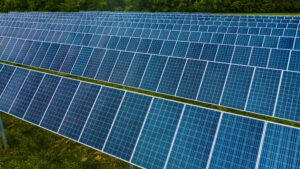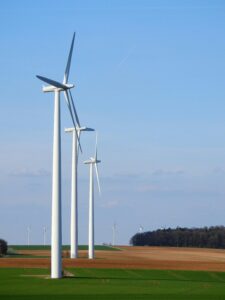The Future of Renewable Energy: 2025 Guide to Clean Power Revolution
Introduction

As the world faces escalating climate challenges, renewable energy has emerged as the cornerstone of global efforts to reduce carbon emissions, combat pollution, and ensure long-term sustainability. In 2025, the renewable energy sector is not only growing at unprecedented rates but also driving technological innovation, job creation, and geopolitical shifts. This comprehensive guide delves deep into the future of renewable energy, highlighting key technologies, trends, challenges, and the path forward.
1️⃣ Understanding Renewable Energy
Renewable energy refers to energy derived from natural sources that replenish themselves over time. Unlike fossil fuels, these sources produce little or no greenhouse gases. The primary types of renewable energy include:
-
Solar Energy
-
Wind Energy
-
Hydropower
-
Geothermal Energy
-
Biomass Energy
-
Ocean Energy
2️⃣ Why Renewable Energy Matters
-
🌎 Climate Change Mitigation: Reduces greenhouse gas emissions.
-
💨 Air Quality Improvement: Decreases air pollution-related health issues.
-
🔋 Energy Security: Diversifies energy sources and reduces dependence on fossil fuels.
-
💰 Economic Growth: Creates millions of new jobs globally.
-
🔧 Technological Innovation: Advances in storage, grid management, and efficiency.
3️⃣ Key Renewable Energy Technologies in 2025
3.1 Solar Energy
Photovoltaic (PV) Panels
-
Efficiency rates have now reached 22%-25% in commercial panels.
-
Innovations include bifacial panels that capture sunlight on both sides.
-
Floating solar farms are expanding in water-rich countries.
Solar Thermal
-
Concentrated Solar Power (CSP) uses mirrors to focus sunlight, generating steam to drive turbines.
-
Ideal for utility-scale energy storage and 24/7 power supply.
3.2 Wind Energy
Onshore Wind
-
Most cost-effective large-scale renewable source.
-
New turbine designs exceed 10 MW capacity.
Offshore Wind
-
Deeper water installations using floating turbines.
-
Europe and Asia lead in offshore wind adoption.
3.3 Hydropower
-
Supplies 16% of global electricity.
-
Innovations include small-scale and run-of-river systems with minimal ecological disruption.
3.4 Geothermal Energy
-
Utilizes Earth’s internal heat.
-
Enhanced Geothermal Systems (EGS) tap previously inaccessible resources.
3.5 Biomass Energy
-
Converts organic waste into electricity, heat, and biofuels.
-
Modern plants reduce harmful emissions using advanced filtration.
3.6 Ocean Energy
-
Tidal and wave power emerging as new frontiers.
-
Pilot projects in the UK, Canada, and South Korea.
4️⃣ Global Leaders in Renewable Energy (2025)
| Country | Key Strengths |
|---|---|
| China | World’s largest solar and wind producer |
| United States | Leadership in offshore wind and battery storage |
| Germany | Advanced grid integration, community solar |
| India | Rapid solar growth, hybrid energy parks |
| Denmark | Offshore wind leader, green hydrogen |
5️⃣ Integration with Energy Storage
Lithium-Ion Batteries
-
Costs have dropped by 80% over the last decade.
-
Gigafactories increasing global production capacity.
Solid-State Batteries
-
Higher energy density and improved safety.
-
Expected commercial viability by 2026-2027.
Pumped Hydro Storage
-
Most widely used large-scale energy storage system.
Green Hydrogen
-
Electrolysis using renewable electricity to produce hydrogen fuel.
-
Potential game-changer for heavy industry and transportation.
6️⃣ The Role of Artificial Intelligence & Smart Grids
-
AI Algorithms: Predict energy demand and optimize supply.
-
Smart Meters: Give consumers real-time data and control.
-
Distributed Energy Resources (DERs): Microgrids improve resilience.
-
Demand Response Programs: Align energy use with availability.
7️⃣ Policy and Government Support
International Agreements
-
Paris Agreement: Aim to limit warming to below 2°C.
-
COP Summits: Continual negotiations to enhance national contributions.
Incentives
-
Tax credits, feed-in tariffs, and subsidies promote adoption.
-
Carbon pricing penalizes high-emission industries.
Public-Private Partnerships
-
Collaboration fuels innovation, investment, and infrastructure development.
8️⃣ Economic Impact of Renewable Energy

-
Global renewable sector employs over 12 million people (2025 estimate).
-
Solar PV sector alone accounts for 4 million jobs.
-
Transition expected to generate an additional 30 million clean energy jobs by 2030.
9️⃣ Overcoming Challenges
Intermittency
-
Wind and solar output vary by time and location.
-
Solution: Hybrid systems combining multiple sources and storage.
Transmission Infrastructure
-
New high-voltage transmission lines needed.
-
Smart grids minimize energy loss over distance.
Raw Material Dependence
-
Rare-earth metals required for many technologies.
-
Recycling and material substitution reducing dependency.
Political and Regulatory Hurdles
-
Policies must adapt to rapid technological changes.
-
International cooperation critical for cross-border energy trade.
🔟 Future Trends to Watch
10.1 Floating Offshore Wind
-
Deployment in deeper waters unlocks vast wind resources.
-
Projects in Japan, Norway, and California gaining traction.
10.2 Solar Paint and Transparent Panels
-
Buildings may generate power through integrated windows and coatings.
10.3 Advanced Nuclear Fusion
-
Companies like ITER, Tokamak Energy, and Helion making breakthroughs.
-
Potential commercialization in the 2030s.
10.4 Vehicle-to-Grid (V2G) Systems
-
Electric cars serve as mobile batteries.
-
Supports grid stability and peak demand management.
10.5 Global Green Hydrogen Economy
-
Export-import chains forming between sun-rich and industry-heavy nations.
-
Australia, UAE, and Chile emerging as hydrogen exporters.
🔬 Case Study: Germany’s Energiewende
Germany’s “Energiewende” (Energy Transition) serves as a model:
-
Over 50% of electricity now comes from renewables.
-
Aggressive carbon pricing.
-
Community-owned renewable cooperatives.
-
Heavy investment in storage and grid modernization.
🌎 The Geopolitical Impact of Renewable Energy
-
Oil-exporting countries diversifying economies.
-
New energy alliances forming (e.g., EU-Africa solar projects).
-
Reduced fossil fuel dependency shifts global power dynamics.
📈 Renewable Energy Market Projections
| Year | Global Market Value |
|---|---|
| 2022 | $881 billion |
| 2025 | $1.2 trillion |
| 2030 | $2.1 trillion |
(Source: BloombergNEF, IEA, IRENA)
🌱 How Individuals Can Support the Transition
-
Install solar panels or subscribe to community solar.
-
Drive electric or hybrid vehicles.
-
Support pro-renewable policy initiatives.
-
Reduce personal energy consumption.
-
Invest in green energy mutual funds or ETFs.
Conclusion
The renewable energy revolution is well underway, offering humanity a viable path toward a cleaner, more sustainable, and prosperous future. As technology advances, costs fall, and global cooperation strengthens, renewable energy is poised to dominate the 21st-century energy landscape. For nations, businesses, and individuals alike, investing in renewables is no longer just a moral imperative—it’s an economic one.




